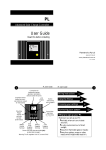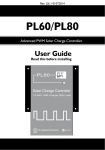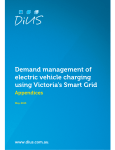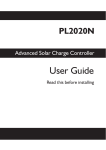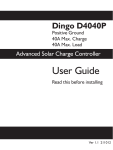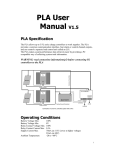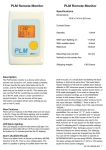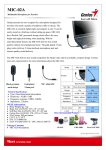Download User Manual - Voltscommissar Home Page
Transcript
Domestic Solar Photovoltaic Off-Grid Electric System (15 Wolseley Parade, Kensington) User Manual 3rd Edition 13 September 2013 Contents 1. Why? 2. How? The technology. 3. How much? Rough cost estimates and comparisons to mains electric power. 4. Safety. 5. Living with feast and famine: adapting daily energy usage to the seasons and the weather. 6. Documentation and Maintenance. 1. OFF-GRID: WHY? 1.1 Climate Change – if all developed nations mandated a system like this for household electric power, then the world could immediately dismantle most non-industrial electricity grids, and thus make a huge switch to electricity from pure, clean, renewable sources. 1.2 Black Saturday – 7th February 2009 was the day that many people were killed by a preventable industrial accident: technical evidence presented at the Victorian Bushfires Royal Commission strongly suggests that the most deadly fire was ignited by sparks from a fallen rusty power line, and that that line would not have fallen down if it had been properly maintained. This project is to demonstrate that all rural households could easily take direct action to eliminate all high voltage (distribution) power lines from thinly populated rural regions across the state, thus eliminating the possibility of those lines falling into a dangerous state of disrepair through neglect (such as may happen as a result of dangerous, inappropriate corporate risk management strategies). 1.3 Smart meters = skyrocketing electricity prices – Abuse of market monopoly power by electricity companies has led to inefficient empire-building of unproven worth (to the national economy). There is no more egregious example of this than the Victorian “Smart Meter” program. If you do not want a Smart Meter, the choice is clear: get off the power grid!! 1.4 Smart Meters and tariff differentials make emissions reductions much more difficult: Smart meter programs have been intentionally designed to change consumer behaviour. Cheaper off-peak electricity prices encourage consumers to conserve energy in the daytime, and shift their power usage to nights and weekends. By flattening Victoria's daily load profile, it is correctly argued that economic efficiency is achieved for the exsiting baseload coal infrastructure. Unfortunately it is also an efficient way of perpetuating the polluting status quo indefinitely into the future. The way to retire highly polluting brown coal baseload generation is to stage a mass walk-out on this monopolistic scam: cut your connection to mains electricity, and provide your own, rather limited, night-time baseload power from batteries. 1.4 Independence and Resilience – competing against monopoly power. This very cheap system is a real challenge to operate during short cloudy winter days. At other times of the year it is a pure joy to think of free energy from the sun, not relying on filthy fossil-fuelled electricity, and having a cost-competitive alternative. 2. OFF-GRID: HOW? SOLAR THERMAL: “Solar panels” have been around for at least 100 years. They started out as flat metal plates with water pipes closely attached. They were for heating water. Such flat plate solar thermal collectors are a neglected technology that function extremely well, and should be manadatory wherever hot water is needed, whether in residential, commercial or industrial settings. Because solar hot water panels are in direct competition with baseload electric power and other fossil-fueled energy sources such as petro-methane (cunningly marketed as “natural gas”), they are not encouraged by governments. If every household in Australia had a compulsory solar hot water system, then members of the public could compete with great economic efficiency against fossil fuel companies, and slash national greenhouse emissions by 40 million tonnes CO2 annually. SOLAR ELECTRIC: Solar photovoltaic panels produce direct current (DC) electricity, so are commonly known as “solar electric” panels. They have nothing to do with producing hot water, and it would be extremely inefficient to use solar electric panels for heating large quantities of hot water for baths or showers. ENERGY STORAGE: To have a modest amount of solar electric power once the sun goes down, or even on a heavily overcast day, it is necessary to store solar energy somewhere. This house uses battery storage, but also a novel and unusual alternative: (a) Lead-Acid Batteries: there are four large 12-volt “truck” batteries in a box under the fridge. Each battery has a capacity of 200 Amp-hours. They are wired up to give 24-volt power. The total storage capacity is only 10 kilowatt-hours (25 volts x 400 Amp-hours). (b) Solar Eutectic Refrigerator: A small bar fridge has been modified to become an important integral part of the household energy system. The freezer compartment is packed with anti-freeze solution (a mix of water and ethanol): when this stuff freezes, it is an “energy bank”: an ice store that can be used every night to keep the whole fridge cold without the need for any nighttime electricity consumption. In this way it functions as a virtual battery, using the sun to make ice during the daytime, and delivering a “baseload energy service” 24/7. During cloudy winter spells, this fridge can be safely turned off for up to 36 hours, saving about 30 Amp-hours (about three-quarters of a kilowatt-hour) of drain on a depleted battery system. THE CHINA SYNDROME: The rise of China as a cheap manufacturing centre is supported in large part by a heavily managed exchange rate. As a consequence Australia is being flooded with very cheap solar photovoltaic panels, inverters and deep-cycle batteries. LOW CARBON LIFESTYLE IS HERE TODAY: This off-grid project is a demonstration of what can be achieved in specific niche applications -- without any public subsidy – to provide economically efficient bypass of monopoly mains electricity. A small household of considerate individuals can cooperate to mitigate their energy usage at night and during cloudy weather, avoid electricity bills, and live a very low carbon lifestyle today, rather than waiting for governments and Big Business to get their act together. This house still uses petro-methane – obviously a potent fossil fuel – for cooking, heating and hot water. If occupants really want to slash their greenhouse gas emissions, they would also need to be frugal in their use of this polluting energy resource. 3. HOW MUCH? This project was done on a DIY basis by the landlord/owner. In round figures the spend was: * Eight 190-watt solar photovoltaic panels at $169 each $ 1,352.00 * 1.5 kilowatt inverter $ 2,000.00 * Plasmatronics PL60 solar charge controller $ * Four 12-volt, 210 Amp-hour AGM batteries @ $400.00 ea. $ 1,600.00 * Fuses, cables, conduits, circuit-breakers, junction boxes, etc. $ 950.00 _________ $ 6,500.00 Total: 600.00 For any small one- or two- person household, where gas or wood can be used for heating, cooking and hot water, it now makes huge economic sense to cut yourself free from the electricity grid, because you modest electricity usage becomes extemely expensive once fixed service charges are heaped upon the cost of the actual electricity consumed. Even if the circumstances midwinter may dictate that your daily consumption should fall to 2 kWh or less, there is a good argument to be had that such a household is providing “economically efficient market bypass” of a monopolistic energy source. Capital expenditure of $4,400 excluding batteries is a 25 year investment, so it costs about $200 per year to finance. If the $1,600 battery bank can be coaxed into five years of useful service, then its cost per year becomes $320. So very roughly if your power bills are round about $520 per year ($130/quarter) then radical energy conservation and off-grid power -- as exemplified here – should be carefully researched. Even in a break-even situation, there is an enormous “feel good factor”: the feeling of empowerment that comes with an independent, non-polluting energy source. 4. SAFETY Safe maintenace of the system requires safe shut down, and this is easily achieved by pulling the handle on the main isolation “switch” (a triple fuse holder). As soon as the three fuses are disengaged from their contacts, the solar panels, the solar controller, and the battery array are effectively isolated from each other. This DC “extra low voltage” (ELV) system has been installed by a competent person|1| with decades of practical experience with electronic construction projects, and who from 1995 to 2003 was the hands-on owner/operator of a wind farm called the Breamlea Wind Generator, which fed 100,000 kWh of renewable power annually into Powercor's electricity grid south of Geelong. For this solar house project, all applicable safety requirements as set out in the relevant Australian Standards2 have been complied with. Direct current ELV is inherently safe from an electric shock perspective, but there are potential dangers from fire and hydrogen gas build up. Both risks have been comprehensively addressed as follows: 1 2 In Victoria, extra low voltage systems are allowed to be installed by competent persons. AS/NZS 3000 Wiring Rules ; AS/NZS 4509 Stand-alone power systems ; AS 4086.2 Secondary batteries for stand-alone power supplies ; AS/NZS5033 PV Array ; AS 3010.1 Electrical Installations Supply Generating set ; AS 3595 Energy management programs ; AS 1359.51 Noise level limits ; AS 1768 Lightning Protection (a) Hydrogen gas: The battery technology chosen is “AGM” - or absorbed glass mat. The charging voltage is such that any hydrogen gas produced is mostly recombined inside the battery. The batteries are enclosed in a ventilated box, with a fan-forced draught discharging a reliable flow of air through a vent to the outside of the building. These measures ensure that an explosive mixture can never accumulate. (b) Fire: Following the Australian Standards for electrical safety is the best way to manage any fire risk. Badly installed direct current power systems pose a risk of short circuits melting wires, or the wrong switches or fuses creating intense arcing. Both of these can ignite fires. Both are virtually eliminated by the use of the right diameter copper wires, the correct placement of sophisticated fuses, and the correct placement of specially designed DC circuit breakers and isolation switches. 5. LIVING WITH THE “FEAST AND FAMINE” of off-grid solar power. Melbourne gets excellent solar energy in summer, and modest sunlight energy in winter. The panels have been carefully placed facing north and tilted at a good angle to make the most of winter sunlight. Analysis of the system's performance indicates that with typical daily solar input during June of 5 to 6 MJ/square metre, the house will have a typical daily midwinter solar budget of a very modest 1.5 kilowatt-hours. The best way to keep the battery healthy during several days of overcast weather is to turn off the fridge for two consecutive nights (and the heavily overcast day in between), also to turn off the inverter each night as the last person retires to bed. This will leave sufficient electricity in reserve for five hours of notebook computing (x1) and five hours of LCD television watching/DVD movie playing, etc. – and of course compact-fluoro lighting of two rooms or three desk lamps.|3| The blower fan in the gas wall furnace is intermittent and uses about 60 watts, so should not be a big problem to squeeze into this energy budget each evening. If an electric blanket is used in each bedroom, it must not be left accidentally operational after the person goes to sleep. When battery voltage is below 24 volts, a hot water bottle would be an excellent substitute for using an electric blanket. On sunny days, between 9am and 3pm, the more energy intensive tasks should be performed, e.g ironing clothes, baking bread in a breadmaker, vacuuming carpets, mowing lawns with an electric mower or line cutter, or washing clothes in an efficient front-loader washing machine (it must be one without an inbuilt heating element). Because a low-power inverter has been supplied, there may need to be some arbitration and scheduled timing of these tasks, to ensure the inverter does not get overloaded. Such scheduled “gentle” power usage also means more efficient usage of stored battery energy. Some sunny days in winter must be reserved for charging flattened batteries, so the presence of bright sunlight does not automatically mean people can do every high-energy task on the list above. It might occasionally be necessary to do a load of washing at the laundromat, or defer carpet vacuuming for a few days. Because battery life is shortened by repeated deep discharging of the batteries, a battery surcharge schedule will be mandatory in the Tenancy Agreement. Charges will be levied based on daily data recovered each month from the PL60 solar control box. The PL60 records minimum voltage in each 24-hour period, starting at midnight. An approximate instantaneous readout of battery voltage is displayed by the BATTERY HEALTH METER (analogue voltmeter), with its colour-coded dial 3 3 x 15 watt CFL globes for the seven hours from 4pm to 11pm is only 350 watt-hours of energy. indicating as follows: green = FREE ELECTRICITY, if minimum daily voltage 24.6 volts or above; yellow = $1.00/day when min. recorded voltage in the range 24.0 to 24.5 volts; orange = $2.00/day when min. recorded voltage in the range 23.5 to 23.9 volts; red = $3.00/day when min. recorded voltage in the range 23.0 to 23.4 volts black = $4.00/day penalty zone, for any day where min. voltage goes to 22.9 volts or lower. Both the tenant and landlord will have read-only access to the secure daily data held in the PL60. After a short period of occupancy, it should become very easy for the tenant to plan power usage for the next day or two, based on time of year, weather forecasts, and the battery health status. The landlord asks that that when it comes to a free choice between paying battery penalty charges and conserving power usage, the tenant's preferred default option is to conserve power. 6 Documentation and Maintenance 6.1 Inventory 8x Tianneng TN-72-5M/190 solar photovoltaic panels (each 24 volts nominal) totalling 1,520 watts, all wired in parallel (i.e. also 24 volts nominal), with each pair delivering power via 4mm 2 tinned copper cable fully enclosed in conduit; 1x Midnite Solar rooftop junction box with two “NOARC” brand 25Amp bidirectional double-pole circuit breakers; Six metres of 25mm2 tinned, double-insulated copper cabling in conduit safely carries the 24-volt DC electric power indoors. Peak solar current approximately 42 Ampere; 1x Plasmatronics PL60 solar controller, a “common positive” PWM device; 4x sealed AGM lead-acid batteries 12-volt, 210 Amp-hours each, in a 24-volt configuration; 2x Pentium-III cooling fans, reconfigured as battery box ventilators; 1x isolator switch and fuse holder. containing: 2x 160A HRC fuses for battery isolation 1x 63A HRC fuse for solar array isolation; 1x analogue expanded scale voltmeter, with colour-coded dial to give the occupant instant and continuous feedback of the main battery voltage and health status; 1x Invertek Powertek 1,500 watt pure sine wave inverter; Inverter handbook; PL60 User Guide; 1x battery hazard sign; 1x shutdown procedure placard; 1x info sheet placard displaying fault current data; All requisite signage at the main LV switchboard, located: hallway beside the front door. 6.2 ELV System Schematic Circuit Diagram 6.3 Maintenance. The two key areas of maintenance for the tenant are: A. Maintain the battery voltage above your target threshold voltage, to keep the batteries always in a healthy state of electric charge, thereby minimising or avoiding the financial charge. This is achieved chiefly by conserving power usage each evening, and 24/7 during long spells of cloudy weather. Historical data analysis of available daylight (raw solar energy) for all seven winters in Melbourne from 2007 to 2013 indicate that usage restricted to 1.5 kWh per day, between 1 June and 15 July will prevent serious battery damage, but incur a battery surcharge of an estimated average $2/day during the six weeks 1 June to 12 July each winter.|4| B. If too many power-hungry appliances are turned on simultaneously, the inverter “squeals” briefly, shuts down and a red light glows on the inverter display panel. Turn off or unplug the offending appliances, turn off the inverter main switch, count to “three” and turn it on again. After the reboot sequence of five seconds, power to the house will be restored. Power-hungry tasks should then be re-scheduled in priority sequence to avoid further blackouts.. Apart from using a small Birko electric jug, an electric blanket, and a hair dryer it is strongly recommended that other heating appliances are never deployed or used. C. If the procedure in “B” above does not restore power, then ring Michael Gunter 0423 970 195 to attend and resolve the problem. IMPORTANT NOTE: If the inverter's “undervolts” LED is glowing upon restart, it means the batteries are dangerously flattened, and the only remedy is four days of bright sunshine. Such an undervolts power blackout would also be indicated by the voltage meter's pointer being well into the black section of the dial. When the inverter fails due to undervolts, the whole house – lights and power points – is in a state of blackout. Obviously deeply flattened batteries must be avoided at all costs. MG 13 September 2013 4 This is probably less than many small households pay daily for electricity usage from the power companies (electricity retailers) during winter. It is conceded that those other households are not strictly rationing their electricity usage. $2.00/day for six weeks is only $84.00











